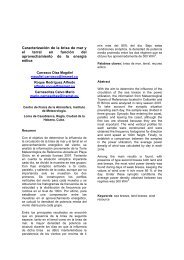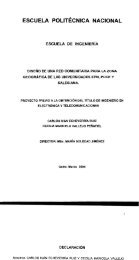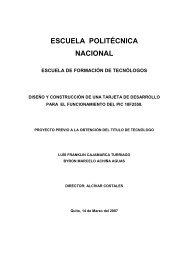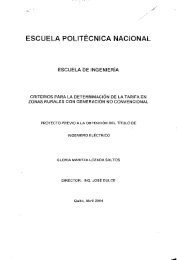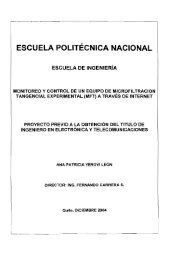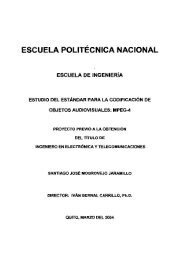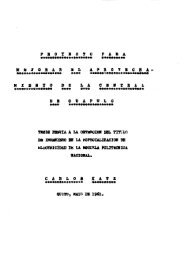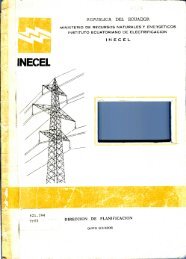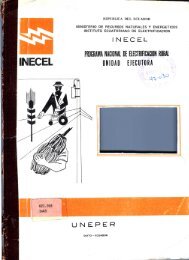Tesis previa a la obtención del Título de Ingeniero en Electrónica y ...
Tesis previa a la obtención del Título de Ingeniero en Electrónica y ...
Tesis previa a la obtención del Título de Ingeniero en Electrónica y ...
Create successful ePaper yourself
Turn your PDF publications into a flip-book with our unique Google optimized e-Paper software.
comm<strong>en</strong>dation H.221<br />
FRAME STRÜCTÜRE FOR A 64 TO 1920 kbit/s CHANNEL<br />
IN AUDIOVISUAL TELESERVICES1'<br />
Basic principie<br />
(revised 1990 and'at Helsinki, 1993)<br />
is Recomra<strong>en</strong>datíon provi<strong>de</strong>s for dynamically subdívlding an overall transmission channel of 64 to 1920 kbít/s into<br />
ver rates suitable for audio, ví<strong>de</strong>o, data and telematics purposes. The overall transmission channel is <strong>de</strong>rived by<br />
ichronízing and or<strong>de</strong>ring transmissíons overfrom 1 to 6 B-connections, from 1 to 5 H0-connect¡ons, or an HH or H¡2<br />
imection. The first connectíon established is the initial connection and carries the inítial channel in each dírection. The<br />
iitional connectíons carry additional channels,<br />
e total rate of transmitted information is called the "transfer rale"; it is possible to fíx the transfer rate less than the<br />
jacity of the overall transmission channel (valúes listed in Annex A).<br />
¡ingle 64 kbit/s channel is structured into octets transmitted at 8 kHz. Each bit position of the octets may be regar<strong>de</strong>d as<br />
ub-channel of 8 kbit/s (see Figure 1). The eíghth sub-channel is called the service channel (SCJ, consístíng of several<br />
ts as <strong>de</strong>scribed in 1.1 to 1.4.<br />
HO, HH or H|,2 channel may be regar<strong>de</strong>d as consisting of a number of 64 kbit/s time-slots (TS) (see Figure 2). The<br />
fest numbered time-slot Ís structured exactly as <strong>de</strong>scribed for a single 64 kbit/s channef, while the other TS have no<br />
¡h structure. In the case of múltiple B or Hg channels, all channels have a frame structure; that in the initial channel<br />
itrols most functions across the overall transmission, while the frame structure ín the additional channels is used for<br />
ichronization, channel numbering and re<strong>la</strong>ted controls.<br />
e térra "I-channel" is applied to the initial or only B channel, to TS1 of initial or only HQ channel, and to TS 1 of HI \,<br />
2 channels.<br />
Frame alignm<strong>en</strong>t signal (FAS)<br />
is signal structures the I-channel and other framed 64 kbit/s channels into frames of 80 octets each and multlframes<br />
F) of 16 frames each. Each multlframe is divi<strong>de</strong>d into eight 2-frame sub-multiframes (SMF). The term "frame<br />
jnm<strong>en</strong>t signal" (FAS) refers to bits 1-8 of the SC ¡n each frame. In addition to framíng and multiframing information,<br />
itrol and a<strong>la</strong>rm information may be inserted in the FAS, as well as error check information lo control <strong>en</strong>d-to-<strong>en</strong>d error<br />
formance and to check frame alignm<strong>en</strong>t validity. Other time-slots are allgned to the first.<br />
s bits are transmitted to Une in or<strong>de</strong>r, bit 1 first.<br />
l<strong>en</strong> an 8 kHz network clock is provi<strong>de</strong>d, FAS is transmitted and received in the leasl signifícant bit of the octei within<br />
h 125 microsecond, e.g. in an ISDN basic or primary rate interface. It should be noted that, where ínterworking<br />
we<strong>en</strong> the audiovisual terminal and the telephone is required, transmission using the network timing is ess<strong>en</strong>tial. In the<br />
eíver si<strong>de</strong>, FAS should be sought in all bit positions. If received FAS position conflícts with the network octet timing,<br />
FAS position is gív<strong>en</strong> priority. This may happ<strong>en</strong> wh<strong>en</strong> the receiver utilizes network octet timing while the transmitter<br />
is not as in a terminal using co<strong>de</strong>es sepárate wíth ISDN terminal adaptor, or wh<strong>en</strong> Ínterworking betwe<strong>en</strong> 64 kbit/s and<br />
kbit/s termináis takes p<strong>la</strong>ce.<br />
; FAS can be used to <strong>de</strong>rive receive octet timing wh<strong>en</strong> it is nol provi<strong>de</strong>d by the network. However, in the <strong>la</strong>tter case,<br />
terminal cannot transmít FAS wíth correct alígnm<strong>en</strong>t into the octet timed part of the network and cannot<br />
¡rcommunicate with termináis which rely only on network timing for octet alignm<strong>en</strong>t.<br />
TTiis Recomm<strong>en</strong>dation completely rep<strong>la</strong>ces the text of Recoram<strong>en</strong>dations H.221 and H.222 pubíished in Fascicle III.6 of the Biue<br />
Book.<br />
Recomm<strong>en</strong>dation H.221 (03/93) 1



